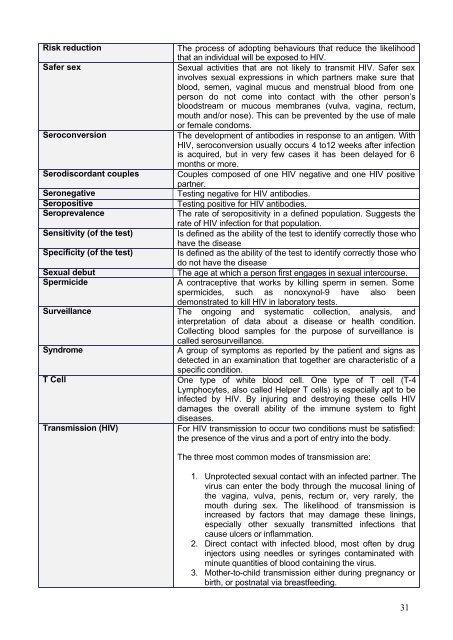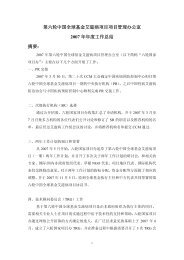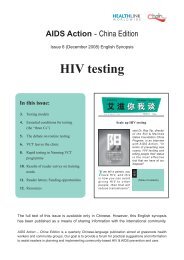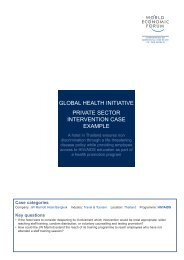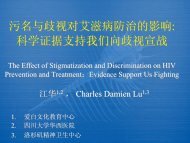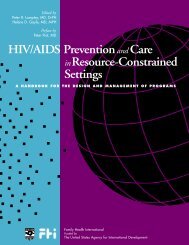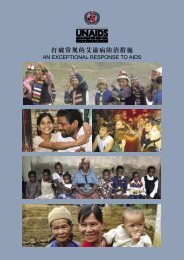What is HIV and AIDS?
What is HIV and AIDS?
What is HIV and AIDS?
Create successful ePaper yourself
Turn your PDF publications into a flip-book with our unique Google optimized e-Paper software.
R<strong>is</strong>k reduction The process of adopting behaviours that reduce the likelihood<br />
that an individual will be exposed to <strong>HIV</strong>.<br />
Safer sex Sexual activities that are not likely to transmit <strong>HIV</strong>. Safer sex<br />
involves sexual expressions in which partners make sure that<br />
blood, semen, vaginal mucus <strong>and</strong> menstrual blood from one<br />
person do not come into contact with the other person’s<br />
bloodstream or mucous membranes (vulva, vagina, rectum,<br />
mouth <strong>and</strong>/or nose). Th<strong>is</strong> can be prevented by the use of male<br />
or female condoms.<br />
Seroconversion The development of antibodies in response to an antigen. With<br />
<strong>HIV</strong>, seroconversion usually occurs 4 to12 weeks after infection<br />
<strong>is</strong> acquired, but in very few cases it has been delayed for 6<br />
months or more.<br />
Serod<strong>is</strong>cordant couples Couples composed of one <strong>HIV</strong> negative <strong>and</strong> one <strong>HIV</strong> positive<br />
partner.<br />
Seronegative Testing negative for <strong>HIV</strong> antibodies.<br />
Seropositive Testing positive for <strong>HIV</strong> antibodies.<br />
Seroprevalence<br />
The rate of seropositivity in a defined population. Suggests the<br />
rate of <strong>HIV</strong> infection for that population.<br />
Sensitivity (of the test) Is defined as the ability of the test to identify correctly those who<br />
have the d<strong>is</strong>ease<br />
Specificity (of the test) Is defined as the ability of the test to identify correctly those who<br />
do not have the d<strong>is</strong>ease<br />
Sexual debut The age at which a person first engages in sexual intercourse.<br />
Spermicide A contraceptive that works by killing sperm in semen. Some<br />
spermicides, such as nonoxynol-9 have also been<br />
demonstrated to kill <strong>HIV</strong> in laboratory tests.<br />
Surveillance The ongoing <strong>and</strong> systematic collection, analys<strong>is</strong>, <strong>and</strong><br />
Syndrome<br />
interpretation of data about a d<strong>is</strong>ease or health condition.<br />
Collecting blood samples for the purpose of surveillance <strong>is</strong><br />
called serosurveillance.<br />
A group of symptoms as reported by the patient <strong>and</strong> signs as<br />
detected in an examination that together are character<strong>is</strong>tic of a<br />
specific condition.<br />
T Cell One type of white blood cell. One type of T cell (T-4<br />
Lymphocytes, also called Helper T cells) <strong>is</strong> especially apt to be<br />
infected by <strong>HIV</strong>. By injuring <strong>and</strong> destroying these cells <strong>HIV</strong><br />
damages the overall ability of the immune system to fight<br />
d<strong>is</strong>eases.<br />
Transm<strong>is</strong>sion (<strong>HIV</strong>) For <strong>HIV</strong> transm<strong>is</strong>sion to occur two conditions must be sat<strong>is</strong>fied:<br />
the presence of the virus <strong>and</strong> a port of entry into the body.<br />
The three most common modes of transm<strong>is</strong>sion are:<br />
1. Unprotected sexual contact with an infected partner. The<br />
virus can enter the body through the mucosal lining of<br />
the vagina, vulva, pen<strong>is</strong>, rectum or, very rarely, the<br />
mouth during sex. The likelihood of transm<strong>is</strong>sion <strong>is</strong><br />
increased by factors that may damage these linings,<br />
especially other sexually transmitted infections that<br />
cause ulcers or inflammation.<br />
2. Direct contact with infected blood, most often by drug<br />
injectors using needles or syringes contaminated with<br />
minute quantities of blood containing the virus.<br />
3. Mother-to-child transm<strong>is</strong>sion either during pregnancy or<br />
birth, or postnatal via breastfeeding.<br />
31


